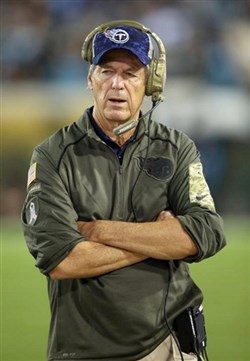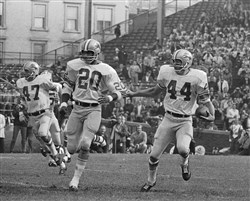VOL. 40 | NO. 24 | Friday, June 10, 2016
Expect new defensive tricks from veteran LeBeau
When Dick LeBeau entered the NFL as a player in 1959, the Houston Oilers were just a glint in Bud Adams’ eye.
That helps put things into perspective as we consider the life and times of the man who is now in complete charge of the Tennessee Titans’ defense. LeBeau has been part of the NFL longer than the franchise for which he now works.
LeBeau will turn 79 two days before the Titans’ season-opener. But when you’re talking about a coach with this kind of resume, age is just a number. Watching him bounce around the practice field like a man one-third his age, you don’t worry about any lack of energy or commitment.
With LeBeau calling the shots, look for the Titans to be more aggressive on defense in the upcoming season. That means more blitzes and more press coverage. Entering his 44th year of coaching, LeBeau prefers to attack rather than react.
Of course, he is at the mercy of his roster.
It is no secret that the Titans remain short on defensive playmakers. Jurrell Casey is an unquestioned talent up front. Brian Orakpo is a proven edge rusher at outside linebacker. Assuming he is back at full speed after an injury-filled 2015 season, Jason McCourty is a solid cornerback.
Otherwise, it is largely a no-name defense. But if LeBeau’s coaching history tells us anything, it is that he finds ways to maximize the available talent.
This is LeBeau’s second year with the Titans. Former head coach Ken Whisenhunt hired him in February 2015 as assistant head coach/defense. In that role, he worked with defensive coordinator Ray Horton.
You know what they say about too many cooks. The same is true for too many defensive coordinators. Last year marked the second time in three seasons the Titans tried a two-headed approach to running the defense. Both times, the head coach got fired.

Titans coach Dick LeBeau enters his 44th year in the NFL with a mission to take the Titans' defense to new levels, with a more aggressive, attacking style of play.
In 2013, Mike Munchak brought in Gregg Williams under the title senior assistant defensive coach to work with Jerry Gray. By the end of a 7-9 season, players like Bernard Pollard were openly speaking about the need for just one voice. As an alpha coach, Williams couldn’t control himself and struggled to defer to Gray.
“To be perfectly honest with you, Coach Williams, he’s a D-coordinator,” Pollard said. “He’s a lion. He is an alpha male. Guys like that, they want to be in their position.
“He knows and understands the situation that he came out of. He had to take a seat. He’s humbled himself. He’s learned. He’s taught when he had a chance to.”
Last season, Horton called defensive signals but players often looked to LeBeau for guidance. Whisenhunt barely made it to midseason before he was dismissed.
At the end of the season, it was clear that changes needed to be made in the defensive coaching structure. As Mike Mularkey was having the “interim” label removed and being installed as head coach, LeBeau made it clear he wanted to take ownership of the defense.
Speaking at a fan forum sponsored by Nashville radio Station, 104.5 The Zone, Mularkey said LeBeau approached him about assuming defensive leadership even before Horton left to join the Cleveland Browns coaching staff.
“It’s kind of ironic that Coach LeBeau came to me the day before Ray Horton left and said, ‘I’d like to call the plays here next year,’ ” Mularkey recalled. “And I’m like, ‘I’ve got to figure out a way – how do I do this without ruffling the coaching staff too much?’

After intercepting a second period Chicago Bears pass, Detroit Lions cornerback Dick LeBeau (44) tugs on the sleve of teammate Lem Barney (20) to show him where to run. Now, a Titans coach, LeBeau was coaching on the field even then.
-- Ap Photo/Jim Palmer“And the next morning, Ray came up and said, ‘I’d like to go to Cleveland.’ And I said, ‘Well, that’s one way to make sure Coach LeBeau calls the plays.’ And I said, ‘Sure. I think that’s a great idea.’ ”
With that, LeBeau assumed control of the defense. After helping make some adjustments to the unit in 2015, LeBeau told reporters the Titans “are going to change even more” in the upcoming season.
“I think our players responded well to the new stuff, and I think it’s good to have new stuff in so teams that know you well, especially your divisional opponents, they are going to have to prepare for different things,” he said.
“It’s not the same old, same old. There were a lot of ideas we didn’t have time to implement last year, and we can do that now.”
With LeBeau aboard and with the 3-4 alignment in place for a second season, the Titans improved from No. 27 in the league to No. 12 in total defense (342.2 yards per game) and were seventh against the pass (229.9 yards) in 2015. But they also ranked 27th in points allowed at 26.4 per game.
Clearly, much work remains for LeBeau. He appears up for the challenge.
Some refer to LeBeau as the Father of the Zone Blitz – a scheme that features a lineman dropping back into pass coverage while linebackers and/or defensive backs rush the quarterback.
For the record, LeBeau was in just his second season as an NFL assistant coach with the Philadelphia Eagles in 1974 when New England defensive coordinator Hank Bullough and Houston Oilers head coach Bum Phillips began experimenting with the zone blitz.
While LeBeau may not have invented it, he certainly has refined and popularized the zone blitz. On his watch in Pittsburgh, the Steelers defense became known as Blitz-burgh. Working out of a base alignment that included three linemen, four linebackers and four defensive backs, LeBeau brought pass-rushers from different angles in an attempt to confuse the quarterback and affect how pass routes were run.
As unconventional as LeBeau’s schemes may seem at times, it isn’t a fire drill gone bad. Behind the blitz, there is sound pass coverage in the secondary. Even if the blitz doesn’t get to the quarterback, receivers are not running free.
Look for more of that out of the Titans in the upcoming season. You can expect to see Casey, a 6-foot-1, 305-pound lineman who is surprisingly light on his feet, dropping back and covering an area of the field while others try to get to the passer.
From what the defensive players are saying, they have full confidence in LeBeau. They respect their elders.
Reach David Climer at [email protected] and on Twitter @DavidClimer.